Ranking the Nation’s Black Studies Doctoral Programs
 The National Research Council’s ranking of the academic strength of U.S. doctoral programs has not been updated in a decade. In an effort to fill this void, Academic Analytics, a for-profit company, in conjunction with the State University of New York at Stony Brook, has undertaken an analysis of 7,300 Ph.D. programs at 354 doctoral institutions nationwide. The National Research Council’s ranking of the academic strength of U.S. doctoral programs has not been updated in a decade. In an effort to fill this void, Academic Analytics, a for-profit company, in conjunction with the State University of New York at Stony Brook, has undertaken an analysis of 7,300 Ph.D. programs at 354 doctoral institutions nationwide.
The Academic Analytics study examines such factors as the percentage of faculty who have published a book, the average number of books published by faculty members, journal papers published by faculty, citation counts per faculty member, percentage of faculty receiving grants, average dollar value of grant awards to faculty members, and the number of academic awards won by faculty members.
Academic Analytics then uses a formula combining these factors to produce a Faculty Scholarly Productivity Index. It then ranks institutions in 104 different academic disciplines. For example, Berkeley is rated as having the best Ph.D. program in astronomy. Princeton has the highest-rated programs in history, English, and aeronautical engineering. Harvard ranks first in nine disciplines.
There are some major surprises. The top French program is at Indiana University. The leading Ph.D. program in Hispanic studies is found at the University of Kentucky. Penn State has the highest-rated doctoral program in women’s studies, German, anthropology, as well as mass communications.
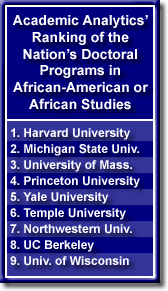 Academic Analytics also ranked the small number of Ph.D. programs in black studies. Some of the programs ranked in this study are concerned with African-American studies whereas others are strictly African studies. Academic Analytics also ranked the small number of Ph.D. programs in black studies. Some of the programs ranked in this study are concerned with African-American studies whereas others are strictly African studies.
Harvard, by a large margin, was ranked as the top program among the nine universities rated in the black studies category. Harvard ranked first in books per faculty, citations per paper, total value of grants, and average amount of grants.
In what may come as a surprise, Michigan State University ranked second among the African-American and African studies doctoral programs. Michigan State did not finish first in any category but its overall rating was good enough for second place.
The University of Massachusetts finished third in the rankings of black studies doctoral programs. It had the highest percentage of faculty members who had published a book. Princeton University, which ranked in fourth position overall, was the leader in most of the categories dealing with publishing in academic journals.
  |
“We have to redefine diversity in much broader terms.”
— Craig Munier, director of financial aid at the University of Nebraska at Lincoln, addressing the need to change the language governing the state’s race-based college scholarship program so that students from all races are eligible for financial assistance (Associated Press, 1-12-07). See story below.
|
Older African Americans Are Flocking to College
Whether the person is white or black, the common vision Americans have of an entering college student is that of an 18-year-old recent high school graduate. But this is not the case, especially for African Americans.
In October 2005, according to a new Census Bureau report, there were 970,000 African Americans ages 25 and over who were enrolled in higher education. This was 42.2 percent of all black students who were enrolled in college or graduate school. In 2005 some 4.5 percent of the entire African-American population over the age of 25 was enrolled in higher education. In contrast, only 3.1 percent of the entire white population over the age of 25 was enrolled in college or graduate school.
If we raise the threshold to 35 years or older, we find 449,000 African Americans who were enrolled in higher education. They make up 19.5 percent of all African-American college students. Some 2.8 percent of all blacks over the age of 35 were enrolled in college or graduate school compared to 1.8 percent of whites over the age of 35.
If we increase the threshold even more, we find that there were more than 200,000 blacks over the age of 45 who were enrolled in higher education. This is double the number of older blacks who were enrolled in higher education a decade ago. Blacks over the age of 45 are almost twice as likely as similarly aged whites to be enrolled in higher education.
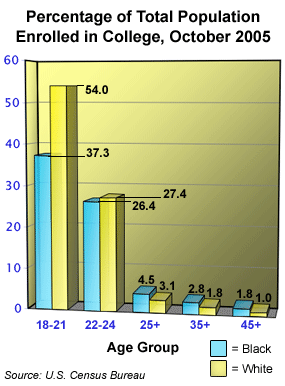
Study Finds That Merit Aid for College Flows Mostly to Students From Affluent Families
 According to a new study from Eduventures, a for-profit educational research firm based in Boston, students from families in the top 25 percent of all earners (those with incomes of more than $111,000) earn three times as much merit aid for college than students from the lowest 25 percent of earning families (those earning less than $37,750). Blacks make up a small percentage of the high-income group and a disproportionately large percentage of the low-income group. According to a new study from Eduventures, a for-profit educational research firm based in Boston, students from families in the top 25 percent of all earners (those with incomes of more than $111,000) earn three times as much merit aid for college than students from the lowest 25 percent of earning families (those earning less than $37,750). Blacks make up a small percentage of the high-income group and a disproportionately large percentage of the low-income group.
Since 1994, according to Eduventures, the percentage of all college financial aid from federal, state, and institutional sources that was merit based has increased from 6 percent to 16 percent.
Racial Differences in the College Experience of the High School Class of 2005
According to the latest Department of Education figures, in the spring of 2005, 354,000 African Americans between the ages of 16 and 24 graduated from high school. Of these, 201,000, or 56.8 percent, had enrolled in either a two-year or a four-year college by October of that year. Of all 2005 black high school graduates who entered college that year, 46.3 percent enrolled in two-year colleges.
For whites, there were 1,799,000 high school graduates in the spring of 2005. Of these, 1,317,000, or 73.2 percent, had enrolled in college by that fall, a rate considerably higher than the rate for blacks. Of those white high school graduates who enrolled in college, 30.3 percent enrolled in two-year programs, a significantly smaller percentage than was the case for blacks.


University of California, Davis
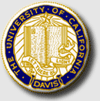
Vice Chancellor — Student Affairs
The University of California, Davis, invites applications and nominations for the position of Vice Chancellor — Student Affairs. The Vice Chancellor is responsible for enrollment services; academic support services; student housing; student health; counseling center; intercollegiate athletics as well as intramural and club sports programs; student life and campus community; campus unions, campus recreation, and campus bookstores.
Candidates should have a record of demonstrated accomplishment in academic leadership and management in student-related positions in a large research university or its equivalent, the ability to work well with faculty, administrators, and student affairs staff, excellent communications and human relations skills, commitment to affirmative action, diversity and community, and a high degree of creative energy and capacity for hard work. A minimum of five years of academic administrative experience is required. A terminal degree and faculty experience are desirable. Candidates who have appropriate academic credentials may qualify for a tenured faculty position.
Review of applications will begin in February 2007 and will continue until the position is filled. Electronic submissions are encouraged. Applications, nominations, and requests for additional information should be submitted to:
Larry N. Vanderhoef, Chancellor
University of California, Davis
One Shields Avenue
Davis, CA 95616
or lnvanderhoef@ucdavis.edu
The University of California, Davis, is an equal opportunity/
affirmative action employer committed to excellence through diversity.

Right-Wing Think Tank Issues Report Highly Critical of Diversity Efforts at the University of Colorado
 The University of Colorado at Boulder has had a rough time in its efforts to bring greater racial diversity to campus. Blacks are only 1.7 percent of the more than 26,000 undergraduate students at the university. Furthermore, a series of racial hate incidents have plagued the campus in recent years. Now, an outside group is openly criticizing what efforts the university has taken to address its racial problems. The University of Colorado at Boulder has had a rough time in its efforts to bring greater racial diversity to campus. Blacks are only 1.7 percent of the more than 26,000 undergraduate students at the university. Furthermore, a series of racial hate incidents have plagued the campus in recent years. Now, an outside group is openly criticizing what efforts the university has taken to address its racial problems.
The Independence Institute, a conservative think tank based in Golden, Colorado, has published a report highly critical of the diversity efforts at the University of Colorado at Boulder. The report is entitled A Color Scheme: Questions Raised by Accounting and Business Practices Within the University of Colorado at Boulder’s Multi-Million Dollar Diversity Administration.
The report says that the university spends nearly $22 million annually on diversity programs. But it is highly critical of these efforts saying most of the funding goes to overhead and administrative costs, with very little filtering down to student programs. The report accuses the university administration of not having clear goals for its diversity efforts and for mounting several efforts that duplicate what others are doing to foster greater racial diversity.
The Higher Education of the Black Woman Who May Be First Lady
Barack Obama, the first African American to head the Harvard Law Review, has emerged as Hillary Clinton’s main rival for the Democratic Party’s presidential nomination. The candidate’s wife has stellar academic credentials of her own.
 Michelle Robinson Obama is a native of Chicago. Her father worked for the city and she attended Chicago’s public schools. Michelle, who at nearly six feet tall looks like she could be a high-fashion model, is a magna cum laude graduate of Princeton University. She went on to Harvard Law School and took a position at the prestigious Chicago law firm Sidley Austin Brown & Wood. Michelle Robinson Obama is a native of Chicago. Her father worked for the city and she attended Chicago’s public schools. Michelle, who at nearly six feet tall looks like she could be a high-fashion model, is a magna cum laude graduate of Princeton University. She went on to Harvard Law School and took a position at the prestigious Chicago law firm Sidley Austin Brown & Wood.
In Memoriam
Harlow Fullwood Jr. (1941-2006)
 Harlow Fullwood Jr., a former pro football player, Baltimore police officer, and fast-food entrepreneur, whose foundation helped more than 1,000 students attend college, died last month from complications relating to diabetes. He was 65 years old. Harlow Fullwood Jr., a former pro football player, Baltimore police officer, and fast-food entrepreneur, whose foundation helped more than 1,000 students attend college, died last month from complications relating to diabetes. He was 65 years old.
Fullwood, the son of a maid and a bus company porter, was a native of Asheville, North Carolina. After graduating from high school he enrolled at Virginia Union University in Richmond on a football scholarship. There he was named an All-American. After being drafted by the Baltimore Colts of the National Football League he left college to pursue his dream of becoming a professional. But after being released from the team in training camp, Fullwood joined the Baltimore Police Department and served on the force for 23 years. During this time he earned an associate’s degree at Baltimore City College and completed his bachelor’s degree at Virginia Union University.
 When he retired from the police force in 1986, Fullwood applied for a franchise with Kentucky Fried Chicken. At the time the company had agreed to expand its franchise opportunities with African Americans, so despite no business experience, Fullwood was awarded two franchises in Baltimore. He eventually operated six KFC outlets and earned a large fortune. When he retired from the police force in 1986, Fullwood applied for a franchise with Kentucky Fried Chicken. At the time the company had agreed to expand its franchise opportunities with African Americans, so despite no business experience, Fullwood was awarded two franchises in Baltimore. He eventually operated six KFC outlets and earned a large fortune.
In 1988 Fullwood created a foundation to provide college scholarships for disadvantaged youths. Since that time more than 1,000 students from Baltimore and surrounding communities have received college scholarships.
Appointments
 • Clarence Newsome, president of Shaw University in Raleigh, North Carolina, was appointed to the North Carolina State Ethics Commission by the majority leader of the North Carolina state Senate. The commission has the authority to investigate ethics violations by any member of the state government. • Clarence Newsome, president of Shaw University in Raleigh, North Carolina, was appointed to the North Carolina State Ethics Commission by the majority leader of the North Carolina state Senate. The commission has the authority to investigate ethics violations by any member of the state government.
• Leslie King-Hammond, dean of graduate studies and professor of art history at the Maryland Institute College of Art, was elected chair of the board of directors of the Reginald F. Lewis Museum of Maryland African-American History and Culture in Baltimore.
Dr. King-Hammond is a graduate of the University of Minnesota. She holds master’s degrees from Louisiana State University at Shreveport and the University of Maryland and a Ph.D. from Johns Hopkins University.
Awards
 • Patrick A. Lewis, chair of the department of political science and history at Hampton University in Virginia, was awarded the Grand Cross of the Most Precious Order of the Princely Heritage by the governor-general of the Caribbean nation of Antigua and Barbuda. Dr. Lewis has served since 1995 as the island nation’s ambassador to the United Nations. • Patrick A. Lewis, chair of the department of political science and history at Hampton University in Virginia, was awarded the Grand Cross of the Most Precious Order of the Princely Heritage by the governor-general of the Caribbean nation of Antigua and Barbuda. Dr. Lewis has served since 1995 as the island nation’s ambassador to the United Nations.
Professor Lewis is a graduate of Hampton University and holds master’s and Ph.D. degrees from the University of Cincinnati.
• Henry Louis Gates Jr., W.E.B. Du Bois Professor of the Humanities and the director of the W.E.B. Du Bois Research Center at Harvard University, was presented with the Jay Hubbell Medal for Lifetime Achievement in American Literary Studies by the Modern Language Association.
|
High-Ranked Law Schools With Large Gains in Black Enrollments Over the Past Decade
Over the past decade the black percentage of all law school students has declined from 7 percent in 1997 to 6.2 percent today. At the nation’s 30 highest-ranked law schools, the majority have shown a decline in black enrollments. Twelve law schools have shown an increase in black enrollments over the past decade while 18 law schools have posted a decline in black enrollments.
The biggest success story has been at the Notre Dame Law School. Today there are 30 black students enrolled at the school, more than double the number in 1997. In 1997 blacks were 2.7 percent of the total enrollments. In 2006 the figure is 5.6 percent.
New York University Law School has also posted strong gains over the past decade. In 1997 there were 74 black students at the NYU law school. A decade later there were 122 black students, a gain of nearly 65 percent.
The law schools at Washington and Lee University and Duke University are the only other high-ranking schools to post black enrollment gains exceeding 15 percent over the past decade.
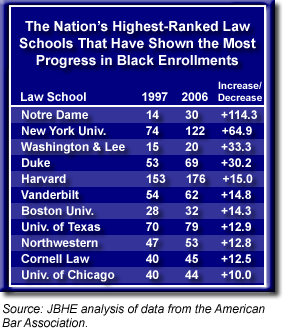
New Nonprofit Seeks to Boost Black Student Enrollments at Elite Colleges
 The Leadership Enterprise for a Diverse America (LEDA) is a young organization that is already having a major impact in increasing the number of black and low-income students who enroll at our nation’s most prestigious colleges and universities. LEDA was founded in 2003 by Gary Simons who spent 25 years as head of Prep for Prep, the New York City group that helps minority students gain access to the nation’s elite preparatory high schools. His new endeavor, LEDA, looks to identify public school students with enormous potential who might not consider applying to a prestigious college or university. The Leadership Enterprise for a Diverse America (LEDA) is a young organization that is already having a major impact in increasing the number of black and low-income students who enroll at our nation’s most prestigious colleges and universities. LEDA was founded in 2003 by Gary Simons who spent 25 years as head of Prep for Prep, the New York City group that helps minority students gain access to the nation’s elite preparatory high schools. His new endeavor, LEDA, looks to identify public school students with enormous potential who might not consider applying to a prestigious college or university.
Using $1.5 million in seed money from a grant from the Andrew Mellon Foundation, LEDA operates two distinct programs, one for rural students from 14 states and another for students in New York City public high schools. Both groups participate in a seven-week summer session before their senior year in high school. New York City students also take Saturday classes.
LEDA’s track record has been impressive. The first class of LEDA national scholars attended the summer institute in 2005 and submitted college applications later that year. This group of students entered college in the fall of 2006. There were 51 students in this group. Of these, 17 enrolled in Ivy League colleges. Another six are students at MIT. Other schools where the 2006 class of LEDA scholars matriculated include Duke, Emory, Georgetown, Northwestern, Notre Dame, Rice, Pomona, Stanford, Tufts, and Spelman.
For the current group of LEDA scholars, 39 students applied for early admission this past fall and 17 were accepted. Among the schools where LEDA scholars were admitted in this admissions cycle are the University of Chicago, Reed College, Brown University, Stanford University (2), Princeton University (3), MIT, the University of Pennsylvania (3), Amherst College, Harvard University, and Swarthmore.

California State University
Sacramento

Tenure-track Counselor Faculty Position,
Psychological Counseling Services (PCS)
California State University Sacramento is seeking applications for a career level tenure-track counselor faculty position in Psychological Counseling Services (PCS). Under the general supervision of the Director, the selected candidate will provide a full range of clinical services and clinical supervision of interns/trainees, as well as participate in campus outreach and maintain professional and scholarly activities. There are limited teaching or research responsibilities. This position pays at the SSP-ARI faculty status salary range and provides excellent benefits.
Minimum Qualifications
EDUCATION/LICENSE
• Doctorate in Counseling or Clinical Psychology, or Master’s Degree in Social Work, or Master’s Degree in Counseling
• California licensure or license-eligible (all supervised hours to be complete by start date)
EXPERIENCE AND SKILLS:
• Experience in college student mental health
• Demonstrated ability to conceptualize cases and make treatment plans, provide both crisis intervention and quality, brief therapy for individuals and couples.
Desired Qualifications
• Substantial clinical experience and interest working with Latino(a) and/or African-American students.
• Comprehensive understanding of issues affecting students from ethnically diverse cultures and/or with recent immigration experiences.
• Bi-lingual/multi-lingual capacity.
• Supervisory experience.
Required Application Materials: 1) current curriculum vitae; 2) names of three professional references; and 3) a cover letter of interest which includes a brief statement explaining your experience in providing services to a diverse university student population.
Application Deadline: Review begins February 15, 2007. Position open until filled.
Starting Date: August 29, 2007
Send Applications To: Search Committee Chair
Mailing Address: Psychological Counseling Services, California State University, Sacramento 6000 J Street Sacramento, CA 95819-6045
Phone Number: 916-278-6416
Email Address: epsteinb@csus.edu
California State University, Sacramento is an Affirmative Action/Equal Opportunity Employer and has a strong institutional commitment to the principles of diversity in all areas.
For more details, please see full position description at: http://www.csus.edu/fas/psych_serv.htm

Nebraska Seeks to End Race-Specific Scholarship Program
 The Minority Student Diversity Scholarship program in Nebraska sets aside $2.9 million in state funds to help black, Hispanic, and American Indian students afford a college education. Now legislation has been introduced to rename the program the Student Diversity Scholarships. Under the new proposal specific references to blacks and other minorities will be replaced by references to students from “diverse, racial, ethnic, and cultural backgrounds.” The Minority Student Diversity Scholarship program in Nebraska sets aside $2.9 million in state funds to help black, Hispanic, and American Indian students afford a college education. Now legislation has been introduced to rename the program the Student Diversity Scholarships. Under the new proposal specific references to blacks and other minorities will be replaced by references to students from “diverse, racial, ethnic, and cultural backgrounds.”
Officials in Nebraska believe that racial references in the legislation currently on the books would be subject to legal challenge. Under the new program, in addition to students from disadvantaged and unrepresented groups, students from rural areas of the state that are underrepresented on some campuses would now be eligible for diversity scholarships. Students who are from the first generation in their families to attend college would also be eligible for Student Diversity Scholarships.
Northwestern University Makes Antique African Maps Available Online
 Northwestern University Academic Library has recently introduced an online archive of historical maps of Africa dating from as early as 1530. The 1530 map was drawn by famed Flemish geographer Gerhard Mercator. The collection contains 113 antique maps including 40 that were published prior to the year 1700. Northwestern University Academic Library has recently introduced an online archive of historical maps of Africa dating from as early as 1530. The 1530 map was drawn by famed Flemish geographer Gerhard Mercator. The collection contains 113 antique maps including 40 that were published prior to the year 1700.
The map pictured here was published in 1630. A label across what we now call West Africa is the legend “Country of the Negroes.”
Scholars who want to view or download the maps can access the collection by clicking here.
North Carolina A&T Gets Tough on Its Students
 The black student graduation rate at North Carolina A&T State University in Greensboro is only 42 percent, slightly below the national average. Further bad news is that the black student graduation rate at the historically black university has declined further in recent years. The black student graduation rate at North Carolina A&T State University in Greensboro is only 42 percent, slightly below the national average. Further bad news is that the black student graduation rate at the historically black university has declined further in recent years.
Now the university reports that one quarter of all undergraduate students who were enrolled during the fall semester are either on academic probation or suspension for failing classes or not making “adequate progress toward graduation.” More than 2,500 students at the university were in academic trouble. At Winston-Salem State University, another historically black state-run university in North Carolina, only 8 percent of the undergraduate students are on academic probation.
North Carolina A&T State University officials note that the university made a conscious decision this past fall to strictly adhere to its policies concerning academic probation and suspension whereas, in the past, enforcement of these policies may have been lax.
Students on probation have one semester to improve their performance or risk being suspended from the university.
The Higher Education of New York State’s New Black High Court Judge
Shortly after taking office, New York Governor Eliot Spitzer nominated Theodore T. Jones Jr. to a seat on the New York Court of Appeals, the state’s highest court.
Jones will be the only African American on the seven-member Court of Appeals. If confirmed by the GOP-controlled state Senate, he will serve a 14-year term on the bench. In making the selection, Governor Spitzer said that the court should reflect “the diversity of our society.” But he added, “Race did not play a role in my selection process.”
Jones has served for 17 years on the state Supreme Court in Brooklyn. He is a native of Brooklyn where his father was a stationmaster on the Long Island Railroad. He is a graduate of Hampton University and St. John’s University School of Law.
  |
69.4% The percentage of all children ages 3 and 4 of white women with a college degree who were enrolled in preschool or kindergarten programs in 2005.
62.1% The percentage of all children ages 3 and 4 of black women with a college degree who were enrolled in preschool or kindergarten programs in 2005.
source: U.S. Bureau of the Census
|
New Networking Group for Black Women in Philosophy
 There are more than 11,000 members of the American Philosophical Association. According to Kathryn Gines, an assistant professor of philosophy at Vanderbilt University, only 112 of these 11,000 philosophers are black. Less than 20 of these are black women. There are more than 11,000 members of the American Philosophical Association. According to Kathryn Gines, an assistant professor of philosophy at Vanderbilt University, only 112 of these 11,000 philosophers are black. Less than 20 of these are black women.
In order to support the development of more African-American women in the field, the Collegium of Black Women Philosophers has been formed. It will hold its first conference this coming September at Vanderbilt University. The organization hopes to help fund the education of black women philosophers and to serve as a networking vehicle for African Americans in the field. “Sometimes all you need is a safe place where you can get some encouragement and mentoring,” Gines says.

Princeton University

Distinguished Visiting Professorship,
The Center for African American Studies at Princeton University
The Center for African American Studies at Princeton supports teaching and research about race, with a central focus on the experience of African-descended people in the United States. With seminar and lecture courses, public lectures and conferences, and the scholarly and artistic work of its faculty and visiting fellows, the center fosters ongoing inquiry into the role of race both in this country and abroad.
The Center for African American Studies at Princeton University invites nominations or self-nominations for faculty from research universities and liberal arts colleges for the Distinguished Visiting Professorship for the 2007-08 academic year. This visiting professorship was established to enable the Center each year to invite one scholar whose research and teaching explicitly examine issues of race in innovative interdisciplinary ways. Candidates in any field may apply, although for 2007-08, we are especially interested in receiving applications from scholars who work in the area of race and public policy. The Visiting Professor may be appointed for one semester or for the entire academic year and will teach one undergraduate lecture course, participate in faculty- graduate seminars, and other activities of the Center for African American Studies.
Letters of nomination or self-nomination should briefly cite evidence of the quality of the candidate’s scholarship and teaching. Please include a curriculum vitae, the names and addresses of three referees, and syllabi of two undergraduate lecture courses.
For full consideration, your materials must be postmarked by February 26, 2007 to:
Center for African American Studies
One Palmer Square
Suite 315
Princeton University
Princeton, NJ 08544
For more information or questions, please contact:
Prof. Noliwe Rooks, Associate Director
609.258.4718
nrooks@princeton.edu
Princeton University is an equal employment opportunity, affirmative action employer.

Grants
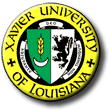 • Xavier University in New Orleans received a six-year, $600,000 grant from the Samuel I. Newhouse Foundation for the establishment of one or more endowed professorships. University president Norman Francis hopes to raise private money and get matching grants from the state of Louisiana to fund up to 12 endowed chairs. • Xavier University in New Orleans received a six-year, $600,000 grant from the Samuel I. Newhouse Foundation for the establishment of one or more endowed professorships. University president Norman Francis hopes to raise private money and get matching grants from the state of Louisiana to fund up to 12 endowed chairs.
 • The Indiana University system received more than $1 million in grant funding from the Lumina Foundation for Education. A large part of the grant will be earmarked for retention programs aimed at black men at the flagship Bloomington campus of Indiana University. Indiana University South Bend and Indiana University Southeast each received two-year, $100,000 grants for their 21st Century Scholars program which provides support services and scholarship funds for low-income students. • The Indiana University system received more than $1 million in grant funding from the Lumina Foundation for Education. A large part of the grant will be earmarked for retention programs aimed at black men at the flagship Bloomington campus of Indiana University. Indiana University South Bend and Indiana University Southeast each received two-year, $100,000 grants for their 21st Century Scholars program which provides support services and scholarship funds for low-income students.
|
 .
.